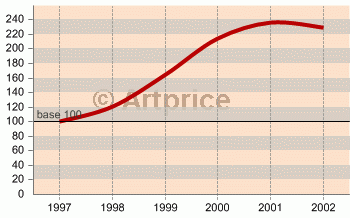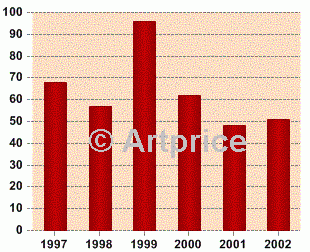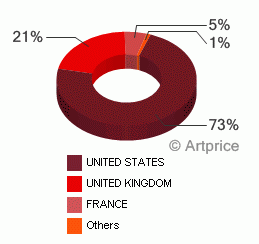Jean-Michel Basquiat (1960-1988)
[18/06/2003]
A year after his premature death in 1989, Basquiat’s paintings were already fetching USD400 000 at auction. In 2002, Profit I sold for USD5 million
Born in 1960 to a Puerto Rican mother and Haitian father, Basquiat left home and school at eighteen. His art was decisively shaped by years spent scratching a living in squats, and doing tags alongside partner Al Diaz under their shared name “Samo” (Same Old Shit). Despite a wealth of visual references to both contemporary and classic art that came to nourish the main body of his work, Basquiat’s work remained marked by his graffiti. Samo, the Basquiat-Diaz duo, began to gain recognition from 1978 through the graphic and poetic quality of their tags. But real success came in the eighties. After breaking up with Diaz in 1979, the young Basquiat exhibited in the Bronx with Jenny Holzer, Kiki Smith and Kenny Sharf. The same year, he was exhibiting alongside Keith Haring, Andy Warhol and Robert Mapplethorpe at the “New York/New Wave” show, which led on to collaboration and joint shows with Warhol. Equally crucial were the three art dealers who picked him out, Annina Nosei, Bruno Bischofberger and Emilio Mazzoli, each marking a further step towards fame. His was a brief, but brilliant career, one of the highlights being his contribution in 1984 to the exhibition “An International Survey of recent painting” marking the reopening of the MoMA in New York. Basquiat’s popularity was already sky-rocketing shortly after his death in 1988. Today he is one of the most expensive artists of his generation.
Artworks at auctions
Jean-Michel BASQUIAT produced some 800 to 900 paintings, and around 1,500 drawings. Most are already in private or public collections. Demand for his work already exceeds supply, and good quality Basquiats are becoming more and more difficult to come by. With so few pieces around, buyers tend not to be picky about any one period or technique in his work. All his art is sought after, and a bare 10% sells for less than EUR10,000. His highest hammer price was for Profit I in 1982, knocked down for USD5,000,000 dollars (EUR5,487,000) at Christie’s in May 2002. The drawings are also very expensive – the great majority priced between 10,000 et 50,000 euros. Large prints like Back of the Neck can also sell for more than EUR10,000.
The market places
Basquiat collectors will find some of his works on paper in France or maybe in Italy. Sometimes London can offer a fine canvas, such as the untitled 1982 large format (181 x 381 cm), sold at Christie’s on 27 June 2002 for GBP 1.25 million (2 million euros). But the biggest sales happen in the US. New York takes 73% of his turnover worldwide and New York is unquestionably where Basquiat sells best. There, for instance, examples of the print Untitled (from Leonardo) sold for USD13,000 dollars in 1999, and USD9,500 dollars in 1998. In France, the same print had struggled to reach USD6,500 dollars in 1997.
Buy or sell
Prices for all mediums have soared recently, gaining more than 129% over 5 years. The paintings are most prized and have risen 183% in value over the same period, and 76% of canvasses on offer at auction find a buyer. The recent craze for Basquiat is reflected in the sale of a 1985 large format, Pharynx, bought in France in 1996 for 130,000 euros and resold in London in 2002 for EUR475,000. Much of the rise in price stems from the shortage of canvasses on the market. In 1997, 36 pieces were on offer against 22 in 2002. For buyers on a lower budget, the increasing demand for Basquiat’s art means that 85% of his drawings put up at auction are sold. The price index for these pieces shows an 80% increase since 1997. Although Basquiat is a contemporary artist, he is already a safe investment, especially as Basquiat collectors already outnumber the works on offer.
Jean-Michel BasquiatArtprice Indexall media categories, base January 1997 = 100, currency: EUR  Jean-Michel Basquiat Lots sold at auctions
Jean-Michel Basquiat Lots sold at auctions  Jean-Michel Basquiat Auction sales turnover 1999-2002 / weight by country
Jean-Michel Basquiat Auction sales turnover 1999-2002 / weight by country  © Artprice
© Artprice




 0
0
